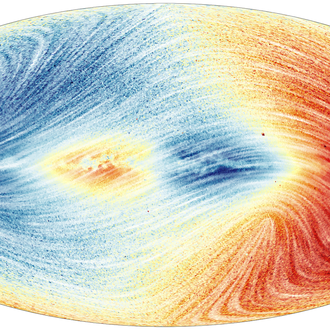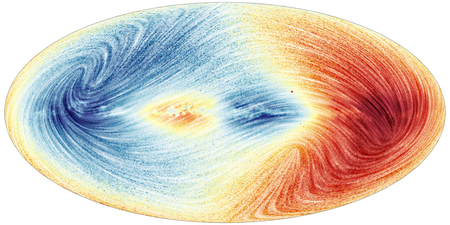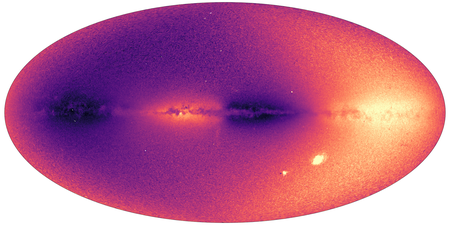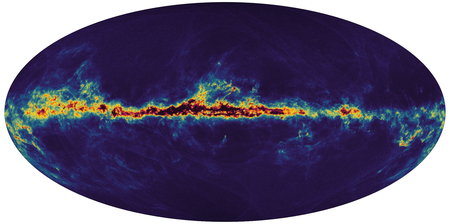A detailed map of our Milky Way

Sky map showing the velocity field of the Milky Way for about 26 million stars. The colours show the radial velocities of stars along the line-of-sight. Blue shows the parts of the sky where the average motion of stars is towards us and red shows the regions where the average motion is away from us. The lines visible in the figure trace out the proper motion of stars. These lines show how the direction of the speed of stars varies by galactic latitude and longitude. The Large and Small Magellanic Clouds (LMC and SMC) are not visible as their stars were not included here.
Credit: ESA/Gaia/DPAC, CC BY-SA 3.0 IGOThe third data release from ESA's Gaia mission contains astrophysical information for 1.8 billion stars in the Milky Way, as well as objects in our solar system and extragalactic sources. With 33 million radial velocities - the speed at which stars move toward or away from us - Gaia also represents by far the largest radial velocity catalogue. The Leibniz Institute for Astrophysics Potsdam (AIP) is one of the Gaia partner data centres and was significantly involved in the calculation of the radial velocities.
In the 17th century, Galileo Galilei was already convinced that the Earth is moving. But not only our Earth, also our star, the Sun, and all other stars, stellar clusters and galaxies in the universe are in motion. In the 21st century, the task of ESA's Gaia mission is nothing less than to measure our home galaxy. Gaia is creating a catalogue containing the position, speed and direction of motion, brightness, colour, temperature and composition of nearly two billion objects in our Milky Way and beyond. The mission thus provides an immense treasure trove of data for a wide range of fields in astrophysics.
Gaia has been continuously observing our galaxy with two telescopes and three instruments since July 2014. The Gaia catalogue published today is based on data from 34 months of observations and is the third of its kind. Two comprehensive Gaia star catalogues were already published in 2016 and 2018, but this third catalogue dwarfs anything that has come before.
Within the Data Processing and Analysis Consortium (DPAC), a consortium of more than 500 scientists, the AIP is responsible for correcting the background light in the spectra, which includes light from unobserved interfering stars as well as stray light. Dr Katja Weingrill, PI of the Gaia project at AIP, explains: “Due to unexpectedly strong stray light on the Gaia detectors, stray light correction has become essential for the evaluation of faint stellar spectra that would otherwise simply be outshone by stray light.”
For the first time, complete spectra will be published alongside the properties of the stars: 219 million stellar spectra from which the brightness, temperature, mass and chemical composition of the objects can be precisely determined, as well as 1 million high-resolution spectra from the Gaia Radial Velocity Spectrometers. In addition, there are the already mentioned 33 million radial velocities, object classifications for 1.6 billion stars, astrophysical parameters such as effective temperature, metallicity, distance for 470 million objects, 10.5 million variable stars, 158,000 objects of our solar system such as asteroids and moons as well as 813,000 double star systems and, what is more, other galaxies and quasars outside our Milky Way. The astrometry and photometry of this Gaia catalogue, on the other hand, is not new; it was pre-published in December 2020 as the first part of the third catalogue. Overall, the third Gaia catalogue (DR3) represents the largest astronomical data collection ever.
This data is freely accessible as of today and can be downloaded directly from the AIP Gaia mirror gaia.aip.de, as the AIP is an official Gaia Partner Data Centre.
Further information
ESA press release
ESA Gaia website
https://www.cosmos.esa.int/web/gaia/dr3-stories
Gaia data access
https://www.cosmos.esa.int/web/gaia/data-access#PartnerDataCentres
Gaia data centre at AIP
https://gaia.aip.de
Images
Sky map showing the velocity field of the Milky Way for about 26 million stars. The colours show the radial velocities of stars along the line-of-sight. Blue shows the parts of the sky where the average motion of stars is towards us and red shows the regions where the average motion is away from us. The lines visible in the figure trace out the proper motion of stars. These lines show how the direction of the speed of stars varies by galactic latitude and longitude. The Large and Small Magellanic Clouds (LMC and SMC) are not visible as their stars were not included here.
Big screen size [1000 x 500, 950 KB]
Original size [2000 x 1000, 1.5 MB]
The rotation of the disc, projected along the line-of-sight, is visible from the alternation of bright areas (moving away from us) and dark areas (moving toward us). Several objects whose radial velocity differs from that of their close environment are visible by contrast: The Large and Small Magellanic Clouds (LMC and SMC) appear as bright spots in the lower right corner of the image. The Sagittarius dwarf galaxy is visible as a faint quasi-vertical stripe below the Galactic Centre. Several globular clusters appear as tiny dots in the image, such as 47 Tucanae, the dark dot on the immediate left of the SMC.
Big screen size [1000 x 500, 770 KB]
Original size [2000 x 1000, 1.3 MB]
This map shows the interstellar dust that fills the Milky Way. The dark regions in the centre of the Galactic plane in black are the regions with a lot of interstellar dust fading to the yellow as the amount of dust decreases. The dark blue regions above and below the Galactic plane are regions where there is little dust.
Big screen size [1000 x 499, 620 KB]
Original size [1999 x 999, 2.2 MB]





